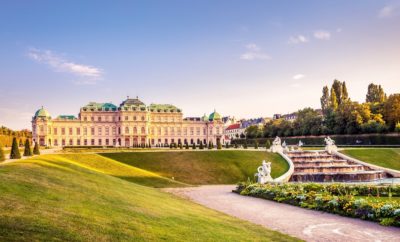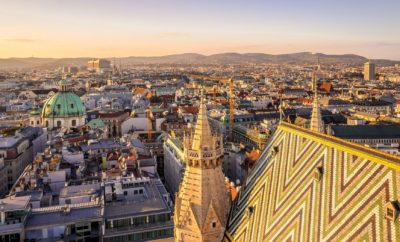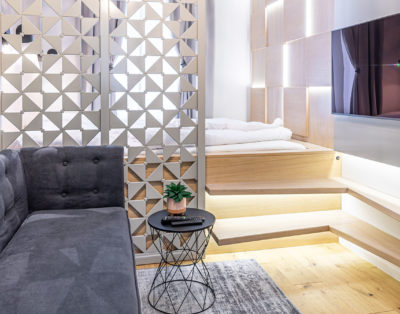Museums in Vienna
Vienna’s museums show works by world-famous artists such as Gustav Klimt, Egon Schiele, Albrecht Dürer and Pieter Bruegel, as well as contemporary art.
The Belvedere Museum in Vienna is one of the most important art museums in Austria; it is housed in the famous baroque building complex from which it takes its name. The complex is composed of two main buildings located at the opposite ends of a large French-style garden: the Upper Belvedere (Oberen Belvedere) and the Lower Belvedere (Unteren Belvedere), both designed by Johann Lucas von Hildebrandt; the Lower Belevedere also includes the Orangery, a smaller building recently converted into a temporary exhibition space. The Belvedere showcases a permanent collection primarily dedicated to Austrian art from the Middle Ages to the present; yet, also artworks from other European countries complete the collection.
The collection is presented in the Upper Belvedere and includes an impressive array of sculptures and paintings by Austrian masters such as Ferdinand Georg Waldmüller , Heinrich Füger, Gustav Klimt (including the famous “The Kiss”), Egon Schiele and Oskar Kokoschka. International artist represented include Jean Louis David, Edvard Munch, Pierre Auguste Renoir, Edouard Manet, Claude Monet, Vincent Van Gogh, Ernst Ludwig Kirchner, and Max Beckmann, among others.
The sections dedicated to Viennese Secession and French Impressionism are widely recognized as among the most important in the world in their respective fields. While the Upper Belvedere houses the permanent galleries of the museum, the Lower Belvedere and its Orangerie usually accommodate major temporary exhibitions, often covering the relationship between Austrian and International artists. Along with the galleries located at the Belvedere Palace, the museum network includes two other venues in Vienna: the Winter Palace, which houses exhibitions of international art, and the 21er Haus, dedicated to the work of modern and contemporary Austrian artists.
The Albertina not only has the largest and most valuable graphical collections in the world, with works such as Dürer’s “Hare” and Klimt’s studies of women. Its latest exhibition collection presents masterpieces of the Modern, spanning Monet to Picasso and Baselitz. As the largest Habsburg residential palace, the Albertina dominates the southern tip of the Imperial Palace on one of the last remaining fortress walls in Vienna.
The collection, which was established in 1776 by Duke Albert of Saxony-Teschen, a son-in-law of Empress Maria Theresia, comprises over one million prints and 60,000 drawings. Famous pieces such as Dürer’s “Hare” and his “Hands folded in prayer”, Rubens’ studies of children and masterpieces by Schiele, Cézanne, Klimt, Kokoschka, Picasso and Rauschenberg are displayed in the rotating exhibitions.
On permanent display in the Albertina’s new exihibition collection are the most exciting art movements of the last 130 years: from French impressionism to German expressionism to the Russian avant garde and the present. Monet’s “Water Lily Pond”, Degas’ “Dancers” and Renoir’s “Girl” can be gazed at in wonder, as can paintings by Beckmann, Macke, Chagall, Malevich, Rothko, Rainer and Katz.
In addition, the Albertina has an architecture and photographic collection (incl. Helmut Newton, Lisette Model), whose works are displayed in special shows.
The Kunsthistorisches Museum (Art History Museum) was built in 1891 near the Imperial Palace to house the extensive collections of the imperial family. With its vast array of eminent works and the largest Bruegel collection in the world, it is considered one of the most eminent museums in the world.
Numerous major art works of European art history, among them Raphael’s “Madonna in the Meadow,” Vermeer’s “The Allegory of Painting,” the Infanta paintings by Velazquez, masterworks by Rubens, Rembrandt, Dürer, Titian and Tintoretto are housed in the paintings gallery. The Egyptian and Near Eastern Collection contains fascinating treasures from mysterious cultures long past.
The Kunstkammer Vienna (Chamber of art and wonders) with rarities from the former treasure chambers and cabinets of curiosities of the Habsburgs opened again in March 2013. The collection is one of the most significant of its kind in the world and displays precious artworks from the Middle Ages, the Renaissance and the Baroque era. The highlights are the collection of Emperor Kaiser Rudolf II, the exotica complex and the famous “Saliera”.
The architectural mirror image of the Kunsthistorisches Museum is the Museum of Natural History on the opposite side, which was also built according to designs by Gottfried Semper and Karl von Hasenauer.
The Leopold Museum is a unique treasure-trove of Viennese art nouveau, the Vienna Workshop and of the Expressionist period. As the most-visited museum in the most fashionable cultural place in the city, the MuseumsQuartier, it houses the most important and largest Egon Schiele collection in the world as well as masterpieces by the founder of the Vienna Secession movement, Gustav Klimt. Also on display are outstanding artifacts of the Wiener Werkstätte, from Josef Hoffmann to Koloman Moser. The light-flooded cube of white shell limestone shows permanent highlights of the collection as well as selected special exhibitions on an area of 5,400 m² over four floors.
42 paintings, 187 original graphics (drawings and colored sheets) and manuscripts (letters, etc.) by Egon Schiele can be marveled at in the Leopold Museum. Many of his principal works, such as the “Self-portrait with physalis” and the “Portrait of Wally Neuzil”, are owned by the Leopold Museum. In the 1950s, its founder, Rudolf Leopold, started collecting large quantities of the extraordinary works of the early Expressionist Egon Schiele. Schiele, who died at just 28 years of age, left behind a considerable body of work, which can be experienced here at close range.
The Fin de Siècle was not only the end of the 19th century. It also literally marked the end an era and was a new beginning in the same breath. It was the birth of Modernism. Which could be seen and sensed, too. Around 1900, Vienna was marked by strong contrasts: splendor and wretchedness, dream and reality, beauty and abyss lay in close proximity to one another. And it was precisely these frictions that led to a turbulent movement of renewal that made Vienna the birthplace of Modernism.
With its permanent exhibition Vienna 1900. Birth of Modernism, the Leopold Museum offers an insight into the enormous wealth and variety of artistic and intellectual masterpieces of this epoch. On more than three floors, around 1,300 exhibits fascinate art lovers. In addition to the expected paintings, graphics, sculptures and photographs, there are also exhibits made of glass, ceramics, metal, textiles and leather. Jewelry and pieces of furniture can be admired, as can as an entire home furnishing exhibit. An exhibition for everyone wanting to experience Vienna Modernism in Vienna in a modern way.
 Naturhistorisches Museum Vienna (Natural History Museum)- The history of the earth and the breathtaking variety of nature can be practically experienced due to 20 million objects: From insects to gemstones and minerals and pterodactyls, the Habsburgs united everything under the roof of this museum near the Imperial Palace. Numerous taxidermy specimens of animals that are either extinct or threatened with extinction make the collection all the more valuable. The showpiece of the collection is the 29,500 year-old and only eleven centimeters tall “Venus von Willendorf”, which was found in the Wachau in Lower Austria in 1908. This masterpiece of Early Stone Age sculpture is one of the most famous archaeological discoveries in the world and is presented in the so-called ‘Venus Cabinet’ alongside the 36,000 year-old Statuette von Stratzing (“Fanny”), as befits its status. Right next door are the prehistoric collection newly opened in 2015 and the ‘Gold Cabinet’ with objects from across five millennia. In the digital planetarium, with its approx. 8.5 meter-diameter inner dome and state-of-the-art Fulldome technology, live presentations of various topics in the fields of astronomy, biology, prehistory and the deep sea are offered several times daily.
Naturhistorisches Museum Vienna (Natural History Museum)- The history of the earth and the breathtaking variety of nature can be practically experienced due to 20 million objects: From insects to gemstones and minerals and pterodactyls, the Habsburgs united everything under the roof of this museum near the Imperial Palace. Numerous taxidermy specimens of animals that are either extinct or threatened with extinction make the collection all the more valuable. The showpiece of the collection is the 29,500 year-old and only eleven centimeters tall “Venus von Willendorf”, which was found in the Wachau in Lower Austria in 1908. This masterpiece of Early Stone Age sculpture is one of the most famous archaeological discoveries in the world and is presented in the so-called ‘Venus Cabinet’ alongside the 36,000 year-old Statuette von Stratzing (“Fanny”), as befits its status. Right next door are the prehistoric collection newly opened in 2015 and the ‘Gold Cabinet’ with objects from across five millennia. In the digital planetarium, with its approx. 8.5 meter-diameter inner dome and state-of-the-art Fulldome technology, live presentations of various topics in the fields of astronomy, biology, prehistory and the deep sea are offered several times daily.
The dinosaur hall presents the skeletons and remains of the gigantic prehistoric animals with a lifelike allosaurus that moves and makes terrifying noises. The model was built for the Natural History Museum on the basis of the latest scientific findings. The world’s first living model of a bird of terror in the original size and new exhibits of a fascinating horned dinosaur skull supplement the impressive permanent exhibition.
Also worth seeing is the biggest and oldest collection of meteorites in the world in the Meteorite Room. 1,100 rocks that “fell from the sky” can be seen there. And with the aid of a simulator, a power meteorite strike can be staged on the screen in 3D.
The mumok – Museum of Modern Art Ludwig foundation Vienna in the MuseumsQuartier focuses its attention on the art of the 20th and 21st centuries. Works by Andy Warhol, Claes Oldenburg, Pablo Picasso, Yoko Ono, Günter Brus and Gerhard Richter invite visitors to engage with contemporary art.
With its collections based on Pop Art and Photorealism, Fluxus and Nouveau Réalisme as well as Viennese Actionism, the mumok combines highlights of societal and reality-related art as well as performance art of the 20th century. The collection comprises around 9,000 works: paintings, sculptures, installations, drawings, graphics, photos, videos, films, architectural models and furniture.
Pop Art is represented amongst other things with works by Andy Warhol and Claes Oldenburg, Robert Rauschenberg and Jasper Johns; Fluxus and Nouveau Réalisme with creations by Daniel Spoerri, Nam June Paik, Yoko Ono, George Brecht and Marcel Duchamp. Viennese Actionism, Austria’s radical and most important contribution to the international development of the Avant-garde movement, is superbly documented with works by Günter Brus, Otto Muehl, Hermann Nitsch and Rudolf Schwarzkogler. A few leading works of the Classical Modern (including by Pablo Picasso, Paul Klee and Piet Mondrian) are also represented in the mumok.
In the past few years, the museum has also succeeded in building up another collection highlight: photographic, video and film works, which have mostly been created in the past decade. Since 2011, a cinema has also been housed in the 4,800 m² building. It was designed by the artist Heimo Zobernig and presents the many connections between the visual arts and film.
The Kunsthalle Wien in the MuseumsQuartier, near the Imperial Palace, focuses on presentations of contemporary and modern art. It is a place for the full variety of international contemporary art and applied contemporary discourses. For this, it develops innovative exhibition and communication formats. The educational program is based on different levels of ways to approach presenting, facilitates an overlap of artistic practice and its theoretical reflection, and promotes an intensive discourse on topical issues of everyday life.
The Kunsthalle Wien MuseumsQuartier is worth a visit not only for the organized events. The former Baroque winter riding hall is getting a functional annex designed by the architecture office of Ortner + Ortner, which combines the historical structure with contemporary architecture. In this way, the Kunsthalle Wien MuseumsQuartier will become a place full of the excitement of art and architecture.
Kunsthalle Wien Karlsplatz is the name of the flexible and experimental outdoor site. The glass cube by Adolf Krischanitz presents art as if in a display window, for a completely different kind of presentation. The café with a gigantic terrace on the glass pavilion is also a hot tip for scene lovers.
MAK – Museum for Applied Arts-Design is one of the main features of MAK. The museum shows furniture, glass, china, silver, and textiles from the Middle Ages to the present day. Precious crafts from the Wiener Werkstätte, bentwood furniture by Thonet and art nouveau highlights such as the gilded design of Gustav Klimt for the frieze of the Stoclet Palais in Brussels.
Bentwood chairs by Thonet are still used in Viennese coffeehouses, and armchairs from the Middle Ages to the present day look absolutely inviting. Biedermeier sofas surprise with pink, green, yellow, or red colors, because the Biedermeier style, with its simple and clear shapes, is considered the cradle of design.
Glass, china, silver, and textiles of the highest quality and in unusual designs were produced at the Wiener Werkstätte, which was founded in 1903 by Josef Hoffmann and Koloman Moser. A hammered silver service by Hoffmann or a black and white vase will thrill not only lovers of art nouveau. In November 2012, the MAK show collection “Vienna 1900” was redesigned and dedicated in its entirety to the development of Viennese arts and crafts between 1890 and 1938. The exhibition rooms recount the story of the search for the modern style via the creation of a unique Viennese style to the confrontation of the Viennese style with the international style and ending with the National Socialists seizing power in Austria.
Also new is the MAK permanent collection Asia, which presents Chinese porcelain, Japanese lacquer work, Japanese wood cuts and Japanese coloring stencil plates. The MAK permanent collection Carpets was reorganized in spring 2014. And the new MAK Design Laboratory makes references between art and everyday life on almost 2,000 m² in the former “Collection of Studies” (Studiensammlung). Contemporary art by Donald Judd, James Turrell and others and 12 sofas by Franz West span the artistic range to the present day.
The Vienna Museum of Technology offers extraordinary insights into the world of technology in a space of 22,000 square meters.
The unique exhibits, from the past to the future, make the museum a showplace for exciting technological developments. Multimedia presentations illuminate the influence of technological achievements on our society, economy and culture. Visitors experience the extraordinary world of technology.
The guided tour through the mine exhibit, for example, shows the world of mining with its language and culture. Many devices that we know from everyday life, such as water pumps, were first used in mines. Mine tours take place daily, and groups can reserve a tour in advance.
Another highlight is the high-voltage demonstration: A singing Tesla coil creates extremely high voltages that form lightning bolts. These discharges fulfill a very special function: they play music. The electricity in the discharge is controlled in such a way that the lightning itself becomes a speaker. Normally we only hear crackling, but the singing Tesla coil makes music. The repertoire ranges from “The Blue Danube” to “Smoke on the Water”.
“Train departing!” at the famous “Schnittlok”. This steam locomotive conveyed passengers through Austria almost 100 years ago. Today it stands in the Museum of Technology and offers insights into the interior of a steam locomotive. Several other technological treats and regular special exhibits make a museum visit an extraordinary experience for visitors both young and old.
The Bank Austria Kunstforum of Vienna chiefly displays art from the classic and modern period and postwar avant-garde.
The entry portal from the house on the Freyung designed by the star architect Gustav Peichl is a work of art in itself. In the capacious rooms, the Bank Austria Kunstforum of Vienna has dedicated itself to the classic modern and postwar avant-garde. A steadily growing number of visitors are flocking to sensational special exhibits by such big names in the art world as Schiele, Kokoschka, Cézanne, Picasso, Van Gogh, as well as painstakingly assembled theme-based presentations. Exhibits by contemporary artists have been presented since 2000.
The Bank Austria’s collection includes more than 9000 works. The highlights include works by Ferdinand Georg Waldmüller, Gustav Klimt, Oskar Kokoschka, Maria Lassnig, Christian Ludwig Attersee, Arnulf Rainer, Franz West, Herbert Brandl and Erwin Wurm.
The Bank Austria Kunstforum is open only when special exhibitions are on display.
Source: www.wien.info







